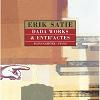Erik Satie, "Dada Works & Entr'actes"
 With yet another Satie collection, LTM is doing great justice to the composer who is oft overlooked but is as important to modern music as any of the trendy experimental composers that get all the limelight. By today's standards much of Satie's work is far from revolutionary, in fact, much of it has fallen into the realm of cheesy but like any art, the original still packs a punch. This collection is the first to cover his Dada-related works.
With yet another Satie collection, LTM is doing great justice to the composer who is oft overlooked but is as important to modern music as any of the trendy experimental composers that get all the limelight. By today's standards much of Satie's work is far from revolutionary, in fact, much of it has fallen into the realm of cheesy but like any art, the original still packs a punch. This collection is the first to cover his Dada-related works.
LTM
Some of these pieces are new to me, some aren’t new but they are far from familiar. At first, Trois Morceaux en Forme de Poire sounds like it is going to be a dull cabaret piece but Satie quickly throws in some curve balls. Almost like the collage technique associated with Dada, Satie seamlessly changes the form of the piece whenever he feels the need. There are slight snippets that are almost recognisable from other pieces, cut out and pasted in like pieces of newspaper in a traditional collage. Despite being broken up into movements, there is that much chopping and changing that it may as well be all one piece. The most interesting thing to note about this piece is that it predates the Dada movement by about 16 years! However, it was performed at a Tristan Tzara soirée in 1923 as Satie felt that these pieces were in Dada’s spirit.
Relâche is divided in two by an entr’acte (between act interval) entitled Cinema (the one piece I have heard before). Relâche was the score for a ballet by Francis Picabia and Cinéma was the soundtrack for a film shown in between the two acts of the ballet. Although only the arrangement for piano is utilized on this recording, the score was originally intended for an orchestra. It would be nice if LTM would consider releasing an orchestral version of these pieces. Not to say that the piano here is anything but great. Pianist Bojan Gorisek is no stranger to Satie and it is possible to hear his enthusiasm for Satie with each note. He plays with a light heartedness and gusto that suits the pieces down to the ground. His performance on the “Chasseur; et début de l’enterrement” episode of Cinéma captures the poignancy of the piece; a death march augmented by Satie in what would prove to be his last composition.
While these were all utilised in Dada activities, it is hard to pigeonhole Satie in as another Dadaist. He was a surreal Dadaist and a Dadaesque Surrealist and he was neither at the same time. This collection captures his spirit more than the Dada spirit (and Gorisek channels Satie's spirit well). It is one of the better entries in LTM's ongoing Satie review, as well as being musically rich, the sleeve notes are also worthy of mention. They include a lot of useful information and pictures although, inexplicably, Man Ray's “Gift” is thrown in amongst the pictures of Satie, posters for his events and photos of the stage layouts for Relâche (though I suppose that it is a Dada statement on the designer's part). Dada Works & Entr’actes is a great piece of Satie and as a fine commentary on Dada from the Satie perspective.
samples:
- Trois Morceau en Forme de Poire: "Maniere de commencement"
- Ragtime Dada
- Cinéma: "Chasseur; et début de l'enterrement"



